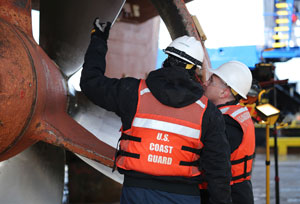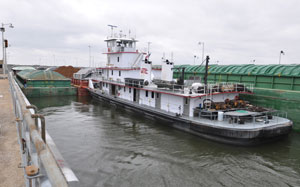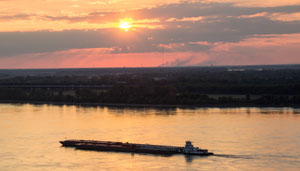There were numerous obstacles during the decade-long period in which Subchapter M, the new regulatory framework for the towing industry, was created. Now, in the second year of the rollout, there is another challenge: COVID-19.
Social distancing requirements due to the coronavirus have made in-person inspections and audits of vessels extremely difficult. To help companies meet Subchapter M requirements, the U.S. Coast Guard has approved remote inspections and audits. In addition, companies can ask for a 90-day extension from their July due date if necessary. Companies should contact their officer in charge, marine inspection (OCMI) to apply for an extension, which will be approved on a case-by-case basis.
Remote methods can include video conferencing and electronic submission of photos, audit reports, recent classification surveys and vessel logs. The Coast Guard also has the option to board a vessel following protective guidelines from the federal Centers for Disease Control and Prevention. The Coast Guard’s Marine Safety Information Bulletin 09-20 contains the specifics for remote work.
 |
|
Coast Guard marine inspectors examine the tugboat Washington at Diversified Marine in Portland, Ore., in March 2019. Coronavirus protocols have led to fewer in-person inspections and surveys and more remote work. |
|
U.S. Coast Guard photo |
Towing companies have two options to comply with Subchapter M: annual Coast Guard inspections, or the use of a towing safety management system (TSMS) approved and verified by a third-party organization (TPO).
Subchapter M requires that companies get a certificate of inspection (COI) for 50 percent of vessels in their fleet by July 20, 2020. COIs must be obtained for 75 percent of the fleet by July 19, 2021, and the entire fleet has to be inspected by July 19, 2022. The COI is good for five years, but vessels must be re-inspected by the Coast Guard or re-surveyed by a TPO each year. There are about 5,500 towing vessels in the domestic industry.
Remotely checking on compliance with Subchapter M requirements has never been done before, however, so companies are facing a new set of challenges in addition to the difficulties of operating during the pandemic.
“This is going to be with us for a long time and we need to figure out how to do business safely,” said Jennifer Carpenter, president of the American Waterways Operators (AWO), who testified in May before the House Committee on Transportation and Infrastructure on how the maritime industry has continued to function during the COVID-19 crisis.
Caitlyn Stewart, the AWO’s director of regulatory affairs, echoed these concerns. “There are a lot of things that need to be considered that don’t have to be considered when someone can be on the vessel,” she said. “We talked about situational awareness issues, connectivity issues, all of those things. For example, safety drills that would have been performed directly pre-COVID are done remotely as tabletop exercises.”
“These are extraordinary times,” said Paul Hite, Subchapter M operations coordinator for the American Bureau of Shipping (ABS). “TPOs need to be flexible, and the Coast Guard has certainly proven themselves to be flexible here, which we appreciate. I just want to make sure we’re not cutting any corners developing these procedures, because these audits are very important.” Hite spoke during a May 12 webinar on remote audits and inspections hosted by the AWO.
Cmdr. Andrew Bender, supervisor at the Coast Guard’s Towing Vessel National Center of Expertise, said companies should work directly with their TPO or OCMI to come up with procedures to show compliance with Subchapter M during the pandemic. “The scope and compliance objectives of an audit and survey do not change based on remote versus physical presence,” he said.
Fortunately, access to the technology needed for remote inspections and surveys is not a problem. “I think the challenges are more related to time, to personnel availability, and all the other things they are asking crew to focus on,” Stewart said.
Bender said he appreciates the work that operators are doing to keep cargoes moving during these difficult times. But he urged companies to try to keep up with Subchapter M deadlines if at all possible. “Extensions are just that,” he said. “You’re exempt from the compliance activity, but it will compress the timeline of the extended activity, and this, of course, can make things more difficult for you.”
And the industry is not keeping up with deadlines. “Nationally, we’re below 32 percent compliance for COI issuance, when we need to be at 50 percent for July,” Bender said. “Although we’re operating in a unique environment … we still have a responsibility to ensure that compliance oversight activities continue.”
At the end of May, the Towing Vessel Inspection Bureau (TVIB) had seen just 40 percent of the volume of surveys and audits compared to the same time last year, according to Tava Foret, the bureau’s executive vice president. She said that 386 members of TVIB, or about 38 percent of companies, had received the required number of COIs. Twenty-three percent of companies had achieved 50 percent compliance.
Foret also said that just because a survey or audit is done remotely, it does not mean that it is less significant. “It’s still expected and anticipated to be a live event,” she said. “You don’t get to phone this one in. You are still putting your name on that report — I don’t care if it’s virtual.”
 |
|
A tow moves through Pickwick Lock on the Tennessee River system. Subchapter M requires 50 percent of each operator’s fleet to have a certificate of inspection by July 20, 2020, but towing group officials have reported problems meeting that target due to the pandemic. |
|
U.S. Army Corps of Engineers photo |
Auditors and surveyors did not receive special training for this remote work, Foret said. But her regular surveyor, for example, decided not to conduct virtual activities, which may be true for other auditors and surveyors as well.
The remote work also raises a larger question: Will this method of conducting inspections and audits continue after the threat of COVID-19 has diminished?
Subchapter M does not address whether inspectors or auditors need to be physically present on a vessel. “That said, the Coast Guard does not find remote activities to be an equal to physical presence,” Bender said. “Although the Coast Guard will leverage what we learn during this time to minimize boots on deck during future Coast Guard inspections, remote work without any physical presence should only be used as a temporary compliance verification measure.”

